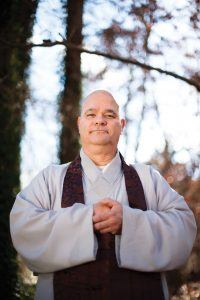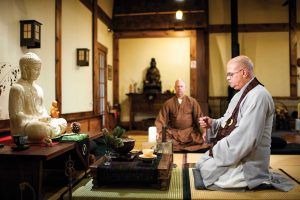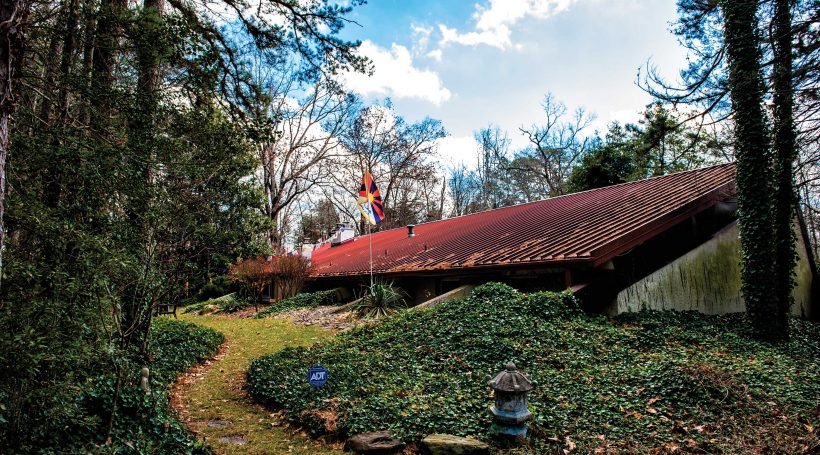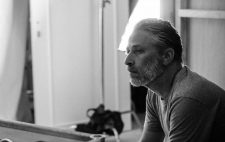If you’re not looking carefully, it’s easy to drive right past the entrance to Pine Wind Zen Center. Off a back road in Shamong, at the end of a winding, tree-lined dirt lane, the red roof of the Jizo-An Monastery comes into view, and the outside world seems to fade away. Colorful prayer flags drift lazily in the breeze, and somewhere, water is babbling.
The property belongs to Stephen Reichenbach, a Cinnaminson native better known in his community as Seijaku Roshi – Japanese for “tranquil teaching master.” The monastery, which opened in 2000, hosts Zen meditation training, weekly talks and programs on Zen-Buddhist teachings. It all happens under the leadership of Roshi, a soft-spoken monk in his early 60s who values silence above most things.

Seijaku Roshi
“My mother will tell you I came out of the womb this way, and she’s probably right,” Roshi says. “I don’t remember a time when I wasn’t drawn to the contemplative life. I’ve always been drawn to the practice of silence. For me, silence is a prayer, a way of life and my refuge. I’ve had two heart attacks over the past five years, and the silence has kept me alive.”
Roshi has been practicing Zen Buddhism for 40 years. He met his first monk while serving in combat in Vietnam – a part of his life he calls “deeply personal,” and declines to talk about.
“When I was 21 years old, I entered my first temple and never left,” he says. “It’s been a way of life that I love. I’m very passionate about it, and it’s been a powerful tool for me to make a difference in the world, which is what we all want to do, and I think where we find our greatest happiness.”
For Roshi, making a difference means helping others. He worked for many years with the Mount Holly-based Francis House of Prayer, helping single mothers in abusive relationships. In 1989, he bought a house in Cinnaminson that became his first Zen center.
“In 2000 I decided I needed to be out in the country,” Roshi says of the monastery’s move to Shamong. “The tradition is for a monastery to be in nature, whether it’s in the woods or the mountains. So I went looking, and when I walked onto this property I turned to the realtor and said, ‘Tell me what you want for it; I’m going to buy it.’”
Roshi had never seen a building quite like the structure that would become his monastery and residence – largely because there are very few buildings like it.
Malcolm Wells, a well-known architect from SJ, who some considered the “father of modern earth-sheltered architecture,” constructed it in 1974. Most of the structure is underground, so the building is naturally cool in summer and warm in winter. The roof is partially lined with solar panels, and windows at ground-level flood the rooms below with sunlight.
Roshi adapted the existing structure to his needs, transforming a concrete garage space into a warm, inviting zendo, or meditation hall. Neatly aligned meditation cushions cover the zendo’s dark hardwood floors, and a Buddha statue overlooks the room.
The real beauty of the Pine Wind Zen Center, though, is outside the monastery, on the meandering paths Roshi has cut through the thick Pinelands brush.
“We own five acres, but the property is surrounded by more than 50 acres of Pinelands Preserve. That contributes to the privacy and the quiet back here,” he says. “When people say, ‘How have you done this?’ I tell them we haven’t done anything. We just moved in. I felt the serene presence as soon as I walked in the door; I don’t know of anyone who comes here and doesn’t have that same reaction.”
The monastery and grounds serve as Roshi’s private residence, but there is a large community of monks, students and lay people who consider the monastery home.
“We have several monks who live off-campus with their families, who have other careers as well,” Roshi says. “Then we have a group of students who are in a regular training program. The third part of our membership is people who participate in our programs and support the monastery through donations. Everything we make pays for electricity and programming – we receive no compensation.”
Roshi says people come to Pine Wind for many different reasons, but nearly all first-time visitors are surprised at what they find.
“I think it’s a combination of people who’ve had some tragic event happen in their lives that’s led them here, others who have felt dissatisfied for a long time and want a change, and a group for whom it’s just the novelty. They’re the ones who heard there’s a Zen master in Shamong. I try to break that myth right away – usually I’m in jeans and a T-shirt.”
Though Roshi will don a traditional monk’s robe for ceremonies and special programs, often the only thing that makes him stand out is his closely shaved head.

Seijaku Roshi and one of his monks meditating in the Zendo
“When one becomes a monk, the shaved head is both a metaphor and a personal reminder that you’re detached from the world,” Roshi explains. “In the days of the Buddha, a person’s hair was a big part of their culture. So cutting the hair represented leaving the ways of that world.”
The members of the Pine Wind Zen Community come from all walks of life, and Roshi says membership is on the rise.
“We have doctors, nurses, teachers, lawyers, truck drivers and retirees,” Roshi says. “Right now we have about 100 people coming through here monthly, and we’re seeing an increase in interest in what we have to offer here.”
Roshi thinks that growing popularity may be the result of a push to educate people about Buddhism. Once people realize they’re not being asked to convert to a new religion, he says, they’re more open to the idea of meditation.
“I was born and raised Catholic, and most of the people who come here are Catholic or Jewish,” Roshi says. “When you’re here, it’s not about if you believe in God or not – that’s up to you. Buddhism is not a religion in the conventional sense. The difference in Buddhism is that it is more accurately defined as a way of life. People of all different faiths are doing this work. They’re looking to deepen their own spiritual path and their own religious life. When you come to the monastery, your religious background doesn’t matter.”
In addition to the spiritual component, Roshi says Zen teachings and meditation help practitioners to live happier lives.
“We’re born into the world perfect and complete, and somewhere along the line we forget who we are,” he says. “It begins the day someone convinces you you’re not good enough. We’ve all heard our parents say, ‘If you want people to like you, you should…’ It creates a lacking self-image, and from that moment on we go in search of fixing that. This means our lives are all about pursuing happiness.”
Roshi says the heart of Zen Buddhism is about self-discovery and learning to recognize the parts of life that are truly important, rather than focusing on the mundane.
“What we’re trying to do here is tell people there’s an alternative to the rat race,” Roshi says. “You have to stop looking for happiness in all the wrong places. Why are we so dissatisfied when we live in a world of natural abundance? The solutions to our stress, fear and anxiety, our personal and global issues, have to do with the way we live our lives. Meditation is training your mind, the same way you go to the gym to train your body. It’s training your mind to quiet down and detach from the habitual behavior that keeps you stressed out all the time. In Buddhism, you are the solution to your problems; so listen up and get with the program.”
The Pine Wind Zen Center is open to the public three weeks out of every month. Though the monastery has specific hours, the public is always invited to show up and stroll around the grounds, where mossy paths lead to hidden shrines, sun-dappled clearings and quiet prayer areas.
“We have hopes of growing,” Roshi says. “We want people to know this is a place of refuge. They can step out, even if it’s just for a couple of hours, and find time to be quiet. The programs we hold are meant to support people in their daily lives, where they are. This is the first time in many years that we are taking the time to welcome and invite people here, the first time we’re really letting the world know we’re back here. Some people say we’re the best-kept secret in South Jersey, but we don’t want to be a secret anymore.”












